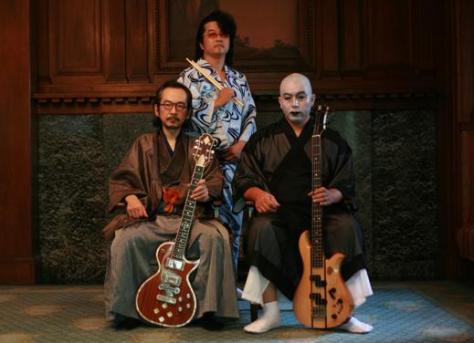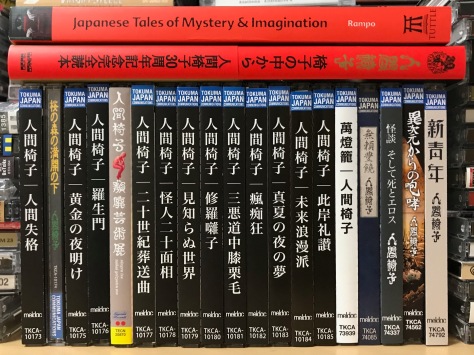Sometimes I envy my wife. She gets into a band and then is content to listen only to that band for months. How much cheaper it would be for me to do the same rather than becoming interested in whole subgenres or periods in rock history. Nah, just get into a band, buy their ten or twenty albums, and just sit back and enjoy day after day.
Well, it does happen from time to time, sort off. There was a time I listened only to Rush for six months and mostly to Yes for three months. There was the time I was into Devin Townsend and even this year I was really into Styx (that ship hasn’t exactly sailed yet either – it’s just in harbour right now).
And then there is Ningen Isu.

By October, I always like to think of what albums will be my final purchases of the year. Of course there are always a few that get through later on in November or even December. But basically, I plan on winding down because during the winter holiday period I don’t have very much time to listen to music as I don’t commute to and from work. I decided this October, while making my Japanese band video, to pick up a few extra albums by Japanese bands. Ningen Isu had already found its way into my collection with four albums, but those four impressed me so much that I decided to get four more before the year end. Then I ordered four more. Within a few weeks, I had 19 of their 21 studio albums, plus three compilation albums I bought because there were songs that were not on the regular albums. I could have saved a bundle by just purchasing downloads from iTunes or even signing up for their streaming service. But I have to have the physical copies. That’s just how I am.

There are several things I love about this band. The first and most obvious is of course that I love their music. Shinji Wajima (guitars, vocals) and Ken’ichi Suzuki (bass, vocals) cover a lot of my favourite styles, including stoner metal, doom metal, stoner rock, progressive rock, heavy prog, heavy psych, hard rock, and more. They are heavily influenced by the early period of heavy metal in the late sixties and early seventies, but also show a strong connection with early eighties heavy metal and even go thrash or speed metal at times. Wajima is a riff master, often said to be the Japanese Tony Iommi, and can pull off one ripping solo after another, each one tailored to suit the song perfectly. Suzuki lays down some pretty mean bass lines too, and the combination of Wajima’s guitar and Suzuki’s bass has been likened to the Alex Lifeson / Geddy Lee teamwork in Rush. After 30 years plus and 21 full length albums, these two are each one part of a three-piece metal music machine.
The third part is of course the drummer. They’ve had four in the band over the three decades. Noriyoshi Kamidate was the original drummer from 1987 to 1992. Iwao Tsuchiya played on two albums in 1995 and 1996. Masahiro Goto played as a stand-in drummer on their 1993 album, “Rashomon”, and then joined the band as the official drummer from 1997 to 2003. Finally, in 2004 they acquired Nobu Nakajima, who has remained the drummer since then. As a side note, both Goto and Nakajima have added some lead vocal work as well.
Lyrically, their songs are inspired by the literary works of Ranpo Edogawa, Ryunosuke Akutagawa, and H.P. Lovecraft, as well as a fair bit of Buddhist themes (Wajima studied Buddhism in university) including lots of songs about Jigoku (Hell). Oh, and space songs. Lots of those too! The vocal style of Wajima and Suzuki is atypical of Japanese rock and metal bands. Their vocal style is very close to traditional Japanese theater and song. This gives their music a unique twist: while it’s impeccable in its likeness to western hard rock and heavy metal, the traditional Japanese vocals make it distinct in both the world of heavy rock music and Japanese rock music. Additionally, their choice of stage dress is with Wajima in traditional Japanese men’s wear and Suzuki in the robes of a Buddhist monk.
As for the band’s history, I have only just begun trying to read through their 30th anniversary publication which includes dialogue between Wajima and Suzuki giving a play by play recount of the making of each of the band’s 21 albums. From Wikipedia, I have learned that the band formed with Wajima and Suzuki in 1987 when soon after Kamidate became the essential third member. Actually, Wajima and Suzuki knew each other from high school and regularly visited a music saloon. It was there that they introduced to each other a song they had each written. Wajima’s was “Tetsugoshi Mokushi-roku (Apocalypse of the Iron Grill)”, and Suzuki offered a track called “Demon” (which, I wonder, could possibly be the song “Oni” from the “Shura Bayashi” album in 2003). After graduation from university, the two met up and first joined a hard rock outfit called Shiné Shiné Dan before setting off to form Ningen Isu. The name comes from the title of a short story by Ranpo Edogawa.
The book is chock full of information you won’t find on the English Wikipedia page or on the band’s English page of their web site. What I learned most recently was that the atmosphere in the band after the third album, “Ougon no Yoake (The Golden Dawn)” was not very good. Still poor, the band shared rooms when they travelled, and the album sales were declining with each new release. Ningen Isu had done very well as an indies band and had been the darlings of the TV show “Ikasu!! Band no Tengoku (Cool!! Band Heaven)”. But each new release sold less than the previous. Kamidate, who was older than the other two, was not pleased with the way things were going and parted ways with Wajima and Suzuki. Suzuki participated in a glam rock festival dressed as Gene Simmons, if I got that bit right, and met Masahiro Goto there. Suzuki asked him to do an album with the band and Goto obliged.
They first contacted Tony Iommi to produce it, but with compliments on their music, he had to decline because of his own busy schedule. They next asked Gene Simmons who agreed to do the job if they’d pay him 2 million yen (about $20,000). Ningen Isu declined on account of not having that much money. Though a track from the album was used by the Aomori Tourism Bureau and a non-album instrumental was used for a Honda bike commercial, the fourth album “Rashomon” didn’t sell much either. Their label, Meldac, released a compilation album of songs from their first four albums with the Meldac lable – “Ningen Shikkaku”, “Sakura-no-Mori-no-Mankai-no-Shita”, “Ougon no Yoake”, and “Rashomon” – and after that, Ningen Isu’s contract with Meldac expired.
Ningen Isu’s musical trajectory over the 30 years can be briefly described here. They began as a retro-sound, early seventies heavy rock band but rather swiftly became a terrific heavy prog rock band by their third album, “Ougon no Yoake”. The later half of the 90’s was spent exploring more variety, dipping into hard rock, heavy psych, and heavy prog, with traces of Japanese folk. From 2000 to 2008, Ningen Isu’s sound went more towards the modern day, heavy alternative band, but there was always room for some metal parts as well. Then they gradually became heavier until 2010. The last five albums, they have been at their heaviest yet and sound like a proper heavy metal band.

I’ll hopefully have something of interest to add for every album, and that might just be a post for a future date. I’m thinking maybe to write a short bit for each album and select perhaps three songs that stand out for me and explain why they do. For now, I have made two videos for Music Is A Journey about Ningen Isu, one general video about the band’s history and albums and another about their compilation albums. I’m also responsible for getting the discography up on MetalMusicArchives, which I am still working on.



